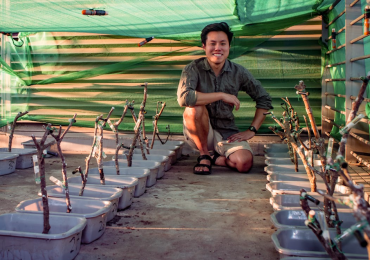In this ‘Behind the Paper’ blog post, author Qiwen Guo, a PhD student in the Institute of Forest Ecology at BOKU University in Vienna, discusses her new article ‘Above- and below-ground phenology of four tree species in mixed forests and monospecific stands’. Qiwen Guo delves into the underground world of roots, asking “do trees adjust their underground schedule when living with different species?”. She also explores the challenges of subterranean research and how she came to study in this field.
1. About the Paper
Every spring, we watch trees burst into leaf, but underground, roots are staging their own dramatic show that scientists have largely missed. We studied when and how roots grow in four common European tree species (oak, hornbeam, linden, and maple), comparing trees living in monocultures versus in mixed forests. The key question is: Do trees adjust their underground schedule when living with different species? This matters because mixed forests cover 60% of global forests, yet root research focuses almost entirely on monocultures.
We discovered that mixing rewrites the underground calendar: trees shift their root growth timing in mixtures, often matching dominant neighbours rather than keeping individual schedules. Roots consistently start growing before leaves emerge, but mixtures amplify the time gap between full leaf development and peak root production. Species mixing also changes how trees respond to temperature seasonally. The broader impact? We’ve been predicting forest behaviour using monoculture-tree data, but roots behave differently in mixtures. With climate change and diverse forest restoration accelerating, understanding these underground dynamics is critical for accurate predictions of carbon storage, nutrient cycling, and forest resilience.
2. About the Research
We worked at an Austrian experimental forest with minirhizotrons—transparent tubes acting as underground periscopes. We photographed roots every 15 days, then spent 30-60 minutes per image tracing individual roots (nearly 7,000 images total!). Above ground, we tracked leaf development with fisheye photos and logged soil temperature every 2 hours.
The challenges? Processing images was mind-numbingly tedious. In mixtures, identifying which species each root belonged to was tricky (7% were impossible to identified). Curious animals stealing our sensors left us equal parts astonished and amused. Our biggest surprise was the magnitude of the timing shift: in monocultures, peak root growth followed full leaf expansion by 2-3 weeks, but in mixtures this gap stretched to about 5 weeks! Also fascinating: hornbeam and oak grew roots through winter at 4°C, while maple waited for 8°C+ spring warmth. The next step? If mixing changes phenology, what about the functional consequences? Does it affect total biomass production? Nutrient uptake capacity? Mycorrhizal colonization patterns? And critically, how will climate-driven shifts in seasonal temperatures disrupt the thermal cues that have regulated these phenological patterns for millennia? These underground mysteries aren’t just academically satisfying, they’re essential for predicting how Earth’s forests will cope with our rapidly changing climate.
3. About the Author
My fascination with nature began during childhood trips with my mother, exploring China’s dramatic Danxia landforms and desert landscapes. Watching how climates shifted and ecosystems adapted sparked a simple question: how does nature orchestrate all this? That curiosity led me to ecology. I completed my Master’s degree at Northeast Forestry University in Harbin under Dr. Wenbiao Duan’s supervision, and I’m now pursuing my PhD at the University of Natural Resources and Life Sciences (BOKU) in Vienna, supervised by Dr. Douglas Godbold.
My current scientific obsession is uncovering the invisible coordination between what trees do above and below ground. We see leaves; we rarely think about roots—yet they’re constantly negotiating with soil, temperature, neighbours, and each other. How do mixed forests rewire these underground relationships? How does forest microclimate shape root behaviour? These questions drive my research on belowground phenology, root-soil interactions, and how tree diversity modifies the hidden world beneath our feet. You can explore more of my work at https://www.researchgate.net/profile/Qiwen-Guo.
Outside the lab, I’m a traveller—discovering new landscapes fuels both my wanderlust and scientific imagination. I’m also obsessed with R&B music, especially The Weeknd (perfect field trip soundtrack). When I need to decompress, I spend time with plants, it reminds me why I fell in love with ecology in the first place.
Looking ahead, I want to deepen my focus on soil-root interactions and how forest microclimates regulate belowground dynamics, especially as climate change rewrites the rules. Like many early-career researchers, navigating funding uncertainty while pursuing long-term ecological questions is challenging—but the privilege of asking questions about nature’s hidden mechanisms makes it worthwhile.
Leave a comment





